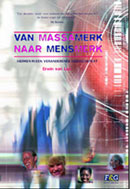No Logo

This book, written in 2000, marks the beginning of the ‘coming out’ of brands: the process in which brands more and more show their true character, start to work completely transparently, and start to involve consumers. In the end, the boundary between employee and consumer will completely disappear. Naomi shows the end of the 20th century’s tough practice of big brands we daily use, like Shell, Nike and McDonald’s. It was a real eye-opener back then. After that, concepts like ‘corporate branding’ and ‘internal branding’ have become popular. Since then brand managers, who were trained in closed and controlled branding, slowly let go of their control. Nike for example published its list of suppliers, including addresses, on its website. This is a very thick book, and at the time it mainly has historical value - not so much inspirational value. For collectors of classics.
 My book ‘Van Massamerk naar Mensmerk’ (From Mass Brand to Personal Brand, Dutch) describes how our media context will change over the coming ten years, how marketing and brands will adapt to this, and how today’s professionals can anticipate. Every day we work on making the world a better place, on a worldwide basis. Every day the future gets one small step closer. As we can take these small steps ourselves today, I closely follow the evolution of media, marketing and brands in the tab
My book ‘Van Massamerk naar Mensmerk’ (From Mass Brand to Personal Brand, Dutch) describes how our media context will change over the coming ten years, how marketing and brands will adapt to this, and how today’s professionals can anticipate. Every day we work on making the world a better place, on a worldwide basis. Every day the future gets one small step closer. As we can take these small steps ourselves today, I closely follow the evolution of media, marketing and brands in the tab  In 2005 my book ‘Van Massamerk naar Mensmerk’ (From Mass Brand to Personal Brand, Dutch) received a top-3 nomination for the Dutch Marketing Literature Award of the year. This prize is presented by the Dutch Platform for Innovation in Marketing (
In 2005 my book ‘Van Massamerk naar Mensmerk’ (From Mass Brand to Personal Brand, Dutch) received a top-3 nomination for the Dutch Marketing Literature Award of the year. This prize is presented by the Dutch Platform for Innovation in Marketing (